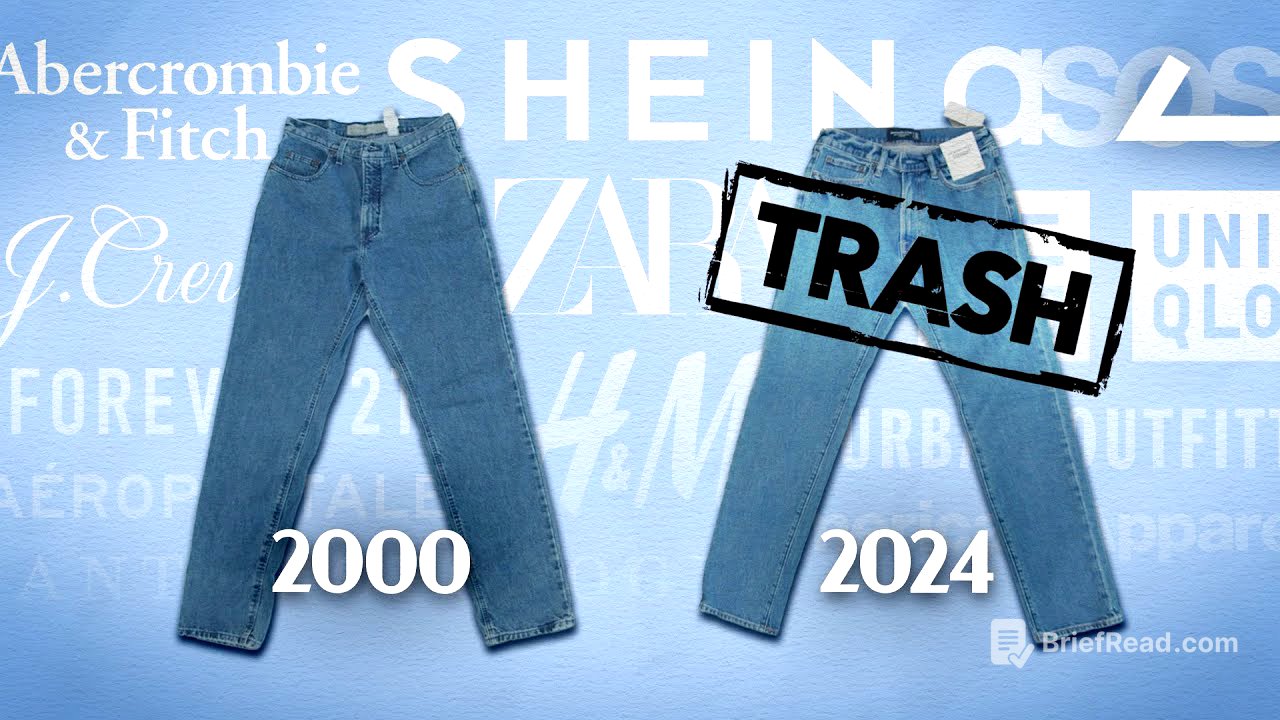TLDR;
This video explores the evolution of the clothing industry, from high-quality, durable garments to the rise of fast fashion and its impact on quality, labor, and the environment. It examines how factors like NAFTA, the expiration of the Multifiber Arrangement, the 2008 recession, and the rise of social media have contributed to the current state of the industry, dominated by companies like Zara and Shein. The video also discusses potential solutions, including legislative efforts to close tax loopholes and enforce environmental and labor standards.
- Clothing quality has declined significantly due to the rise of fast fashion.
- Fast fashion companies exploit workers and contribute to environmental waste.
- Legislative efforts are underway to combat the negative impacts of fast fashion.
Intro [0:00]
The video begins with a shopping trip to Abercrombie, where the narrator observes that the clothing is more affordable but of lower quality than in the past. This observation leads to a broader question: whether clothing quality has declined across the board. The narrator decides to compare clothing items from the 90s and 2000s with their modern counterparts to assess the changes in quality.
Was clothing really better before? [0:55]
The narrator consults with Amanda McCarty, a fashion industry veteran, who confirms that clothing fit and longevity have significantly decreased. The video highlights that Americans now buy five times more clothes but spend half as much of their income on them compared to the 1980s. Back then, brands emphasized the quality and craftsmanship of their products, even at discount stores like J.C. Penney, where suits were marketed for their tailoring and design rather than price.
Zara, Forever 21 and H&M [4:16]
The emergence of Zara marked a turning point with the introduction of "fast fashion." Zara streamlined production by using griege goods and establishing high-tech factories in Spain, connected by an underground monorail. This allowed them to produce and restock styles quickly, responding to emerging trends in as little as 15 days. Zara's success was followed by the rise of Forever 21 and H&M, which further popularized the concept of bringing runway designs to the masses at affordable prices through collaborations with luxury designers.
NAFTA and the Multifiber Arrangement [7:35]
The video explains that the rise of fast fashion was also facilitated by trade agreements like NAFTA, which made it cheaper to produce clothes in Mexico, and the normalization of trade relations with China. The expiration of the Multifiber Arrangement in 2005 removed restrictions on clothing imports, enabling companies to produce goods in countries with the lowest wages and lax regulations.
2000s fast fashion and recession [8:30]
In the 2000s, consumers had a range of buying options, but the 2008 financial crisis led middle-class consumers to seek cheaper alternatives. Traditional retailers struggled to compete with fast fashion brands like Forever 21 and H&M. Retailers maintained price tags but reduced production costs by using synthetic materials, skimping on details, and offering fewer sizes to maintain profit margins.
Quality comparison [10:17]
The video compares vintage and modern clothing items to illustrate the decline in quality. For example, vintage Abercrombie jeans are heavier, made of 100% cotton, and feature a durable metal zipper, while the modern version is lighter, contains elastane, and has a cheaper zipper. Similarly, a vintage Liz Claiborne sweater made of 100% wool is compared to a modern Anthropologie sweater made of 100% polyester.
Shein and the de minimus loophole [13:21]
Shein is presented as the ultimate expression of fast fashion, offering hyper-trendy clothing at incredibly low prices. Shein operates as a marketplace connecting thousands of independent Chinese factories, using real-time feedback to adjust production. The company avoids U.S. taxes by shipping directly from factories and exploiting the de minimis loophole, which exempts packages under $800 from tariffs.
Worker exploitation [15:35]
The video highlights the exploitative labor practices in the fast fashion industry, including unsafe working conditions and long hours. It references the 2013 garment factory collapse in Bangladesh and a 2021 investigation revealing poor conditions in Shein's supplier factories. Additionally, it addresses the issue of forced labor in Xinjiang, China, where a significant portion of cotton used in clothing is produced.
Overconsumption impacts [17:03]
The video discusses the environmental consequences of overconsumption, noting that Americans discard an average of 81 pounds of clothes per year. It highlights the vast amounts of textile waste, including a mountain of discarded clothes in Chile's Atacama Desert. The prevalence of polyester in clothing contributes to the problem, as it takes centuries to decompose.
How to fight back [17:57]
Despite the challenges, the video points to ongoing efforts to combat the negative impacts of fast fashion. These include legislative attempts to close the de minimis tax loophole and introduce environmental and labor standards for the industry. Several brands have also been investigated for using cotton from Xinjiang. The video emphasizes the need for continued action to ensure affordable, high-quality clothing without worker exploitation and environmental destruction.









